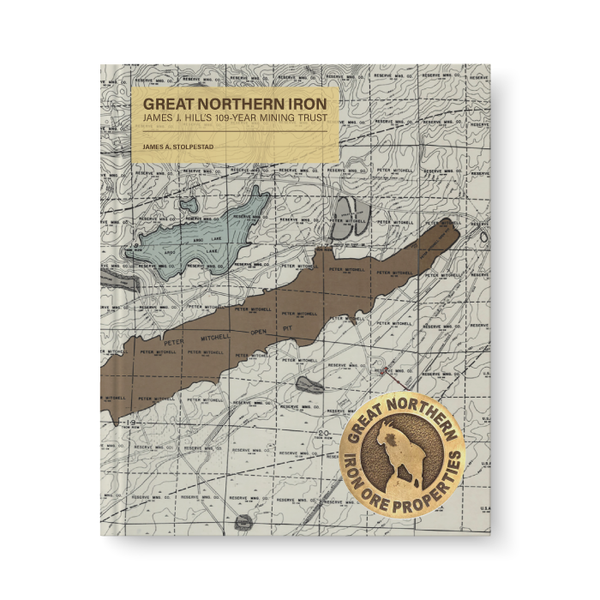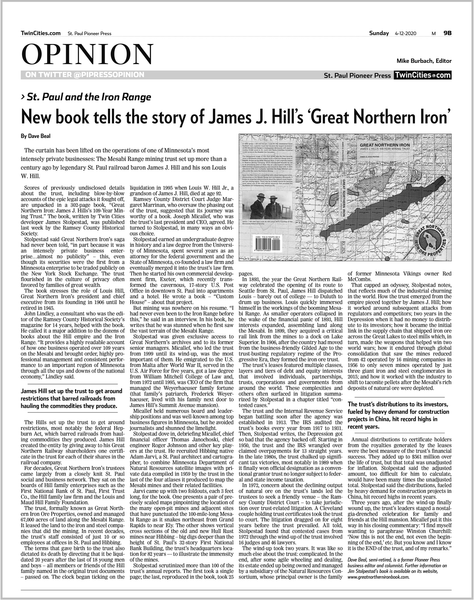Great Northern Iron: James J. Hill's 109-Year Mining Trust
By James A. Stolpestad
Great Northern Iron is a 302-page hard cover book that presents a comprehensive history of the Great Northern Iron Ore Properties, which owned 67,000 acres located in Minnesota's Mesabi Range. The Properties were spun off from the Great Northern Railway in 1906 by distributing Trust Certificates to Great Northern Railway stockholders on the basis of one trust certificate for each share of Great Northern stock.
This volume includes original documents, photographs, maps and detailed tables. It features dramatic 36-inch fold out maps that show the entire Northern Minnesota mining region from both a bird's eye view and in cross section.
The trust was established to comply with the Hepburn Act, which forbade the railroads from hauling commodities they produced. The book stresses the role of Louis Hill, trust president and chief executive officer from its founding until he retired in 1945. Over its lifetime, the trust distributed $561 million to its owners in current dollars, an amount that if adjusted to today's prices would certainly be in the billions of dollars.
Author Stolpestad, a St. Paul lawyer and real estate developer, was approached by Joseph Micallef, the trust's last president with a request to write the book and the promise of exclusive access to GNIOP's archives and former senior managers.
The above summary is adapted from a book review by Dave Beal published in the St. Paul Pioneer Press, April 12, 2020.
The following is a book review by Store Manager Mac McCulloch
Great Northern Iron provides an in-depth look at the one-of-a-kind Great Northern Iron Ore Properties, a grantor trust created by James J. and Louis W. Hill in 1906.
Most people with an interest in the Great Northern Railway know that the railway hauled prodigious tonnages of raw iron ore, and later taconite, from the Mesabi range to its ore docks at Allouez, Wisconsin. Some know that Louis W. Hill convinced his father to invest in iron ore bearing lands at the end of the 19th Century.
This book tells the tale of the major transactions that lead to the railway owning 67,000 acres of land in the Mesabi, the legal problem this ownership presented the Great Northern, and how these lands, plus other odds and ends, were initially (1899) placed in a subsidiary entity. In 1906, the lands in the Mesabi were placed in a trust, the Trust Certificates of which were distributed to railway shareholders to comply with the Hepburn Act, which forbade railroads from hauling minerals that they owned.
Great Northern Iron recounts the role that the trust played in developing the Mesabi, the greatest iron ore deposit in the United States and a key component of our national defense for decades. It includes two, two-sided fold out maps far larger and more interesting than appear in any other book we have ever seen.
It discusses two complex court cases. The first was a challenge to the very existence of the trust by certificate holders Charles S. and Elizabeth P. Arms. The second was a demand for early termination of the trust. The trustees prevailed, at substantial cost, in both cases.
The trust was terminated, by its own terms, on February 28, 2017. Work on the book began immediately thereafter with the full support of the three remaining trustees. The author had full access to the records of the trust and the living memories of the trustees.
The book is in part a personal history of Louis W. Hill, who served as one of four trustees from 1906 until 1945, but more the history of a business that the Hills were forced to create due to the Hepburn Act. If you have an interest in the business history of the Great Northern, of the Mesabi range, or of iron ore mining, this book should be in your library.
Great Northern Iron is a hard cover book of 302 pages printed on 8.5 x 11 coated paper, with dust jacket. It is of excellent physical quality.




